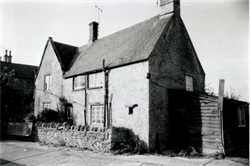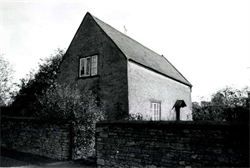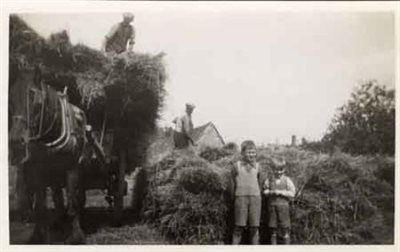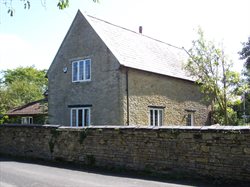Faulkner's Farm, The Marsh
This page was contributed by Pamela HIder


Faulkner's Farm, 1970s [Courtesy of HER]
The Historic Environment for Bedfordshire describes Faulkner's Farmhouse as follows:
C17 or early C18 house. Heightened early C20 and altered late C20. Coursed limestone rubble. Heightened in red brick. Welsh slate roof. L-plan. Stone gable coping to W. wing. This wing has red gable brick chimney stack in rear, E. wall. E. wing has E. gable end stack and W. end ridge stack. Both wings 2-bays in length. Whole building 2 storeys. Irregular window pattern. Windows mainly 2 and 3 - light casements with glazing bars.
The Name Faulkner
The earliest record we have with the name Faulkner (or Falkner) associated with Carlton, is in a conveyancing document (GA327) dated 1674/75. 'Widow Falkner' is mentioned amongst 'owners or occupiers of adjoining lands'. A later document (GA361) dated 1701 refers to: 'A messuage in Carlton, where Jane Falkner widow late dwelt, a close of 4 acres adjoining;". Faulkner's Farm today is next door to The Grange, (formerly named The Moor House), which wasn't built until the 19th century, so that the land on which The Grange was built, plus the acres behind it, would have originally been part of the same close. A site plan of Faulkner's Farm dated 1889 tells us that the total amount of land at the rear of both properties was just over 4 acres (BMB14/A48). Could this have been the close? Put together, it adds up to one possible origin of the farm's name as well as its location.
However, the Parish Registers of Carlton, which contain records of births, marriages and deaths from 1554-1812 (excepting 1645-1657) do not contain a single mention of anyone with the name Faulkner or its variants eg. Falkner, Fawkner, Faulconer. On the other hand, the Parish Registers of Harrold contain several (between 1747 - 1810). According to Land Tax records, a William Faulkner (born in Harrold in 1753) lived and owned land in Harrold from 1797 to 1807, then lived and owned land in Carlton from 1808 - 1816 during which time he is described in documents (X377 series) as a Carlton farmer. He is another possibility as to the origin of the farm's name. Perhaps he was a descendant of Jane Falkner, above? William died in Carlton in 1832 and is buried in the Baptist Chapel graveyard in the Causeway. He may not be connected to Faulkner's Farm at all, but until more conclusive evidence is found, perhaps we should keep him under consideration.
Faulkner's Farm for sale
The first time the name "Faulkner's Farm" appears in our records, is in a document of August 6th 1872 when it came up for auction (GA2148). The sales particulars describe: "36 acres of rich arable & pasture land (mostly opposite the farmhouse across the lane); a small farmhouse with garden attached; conveniently arranged Farm Yard, and Commodious Premises". In addition "The whole is in the occupation of Mr.J.Clark, who is under notice to quit at Michaelmas next". The mention of Mr. Clark is the first time we have been aware of an occupier's name. However, the Conditions of Sale refer to Indentures of Lease & Release dated 1836 between Samuel Rogers and the Rev William Breighton Russell (of Turvey).The Owner of the farm at 1872 is unclear, but the buyer was Henry Keep, who had been living next door at the splendid Moor House for many years.
Henry Keep
Henry was born in 1828 in Newport Pagnell. In 1858, he married Beata von Ochlhaffen of Germany in Liverpool. They and their family, with servants, were settled in the Moor House at Carlton by the 1860s, appearing in the census of 1861, Henry being described as a farmer of 450 acres, employing 14 men and 5 boys. By the 1871 census, he was described as a farmer of 419 acres, employing 26 men and 5 boys. Unsurprisingly, when Faulkner's Farm came up for sale, in 1872, on his doorstep, he bought that too. By the 1881 census, he must have sold off his other property and land holdings, as he is described as farming 40 acres (the acreage of Faulkner's Farm). Curiously, he is now described as a farmer/miller, employing 6 men and 1 boy. Land Tax Records tell us that the owner of Harrold Mills from 1876-1885 was one Henry Keep. In the censuses of 1891 and 1901, he was described as a 'retired farmer' now living in Sussex with his family. The name of his house in Sussex was 'Carlton'. He died in 1904.
End of an era
As Henry contemplated retirement, both Faulkner's Farm and the Moor House came up for auction in 1889 (GA2162). They were offered for sale "in One Lot, and if not sold as a whole, then in Two Lots....". The Moor House received top billing, whilst Faulkner's Farm was "comprising nearly 40 acres of rich Garden and Pasture Land; a Small FARMHOUSE, Stockyards, and convenient Farm Premises, Poultry Houses etc.". More detailed particulars revealed "House: 2 Kitchens, Parlour, Dairy and 4 bedrooms; Farm Premises: Thrashing Barn, Stable, Cart Shed, Cowhouse, Poultry Houses, Loose Box, 2 Open Hovels, large Wood and Coal Barn; together with Stock Yard, Courtyard, small Garden, Orchard (stocked with choice young Apple Trees) and Paddock". The Conditions of Sale refer to an indenture of conveyance dated 1853 between Samuel Rogers and Ann Whitworth. It is unclear who bought the farm, but the 1891 census tells us that John Betts and his family were in occupation. Electoral Rolls show Charles Bettsto be there in 1898 and Jonathan Sharpe to be there 1900-1902. Gerald Eden took on the tenancy in 1907. Shortly after, Mr.Gardiner, a farmer, moved next door and after him came Mr. Potter, another farmer. They might have farmed the land during the next 15 years or so, but the next clear record isn't until March 1927. It is evident from our records that the properties were sold in TWO Lots.
20th century
The Rating and Valuation Act 1925 (DV1/H18) specified that every building and piece of land in the country was to be assessed to determine its rateable value. In March 1927, the owner of Faulkner's Farm was listed as W. Fairey and the occupiers as J. Smith & Sons. The valuer visiting the farm noted 50 acres in two parishes (14 acres in Turvey) and remarked "Very useful holding. Fairey says grass in Turvey will fat a bullock". Another hand has written "I doubt it".
The description of the premises was as follows: "House - stone thatch, front room, scullery, living room, dairy & kitchen. Upstairs 4 bedrooms, no bathroom. Out earth closet, no bathroom. Cooling house, water pumped from a good well, Quite a good house. Buildings: E 3 bay open cart shed, woodshed, 2 loose boxes, 2 cowsheds for 4; W Cowshed for 6, pig sty & loose box; N 3 bay open lean to shed, large barn & chaff house. Next House Cooling house & garage. V gd small set of buildings, quite sufficient for farm, water from pump at house".
Our records show The Smith family to be still in occupation in the 1940s.

Haymaking at Faulkner's Farm c.1940 [Z1306/25/9]
Alfred and Ivy Barker took over Faulkner's Farm in the early 1940s. They raised turkeys to add to their income. In August 1966 fire broke out at the farm, at a disastrous time of year, with all the harvest in. Mr. Charlie Skevington helped Ivy rescue all the turkeys; loading them into the back of her station wagon and driving them to safety. But, it had become more and more difficult to keep the small farm viable, and the fire was the straw that broke the camel’s back. The Barkers left Faulkners Farm in 1970 and it was sold as a private dwelling shortly afterwards. (Unpublished memoir of Carlton & Chellington Historical Society).


Faulkner's Farm 2020